Coin-Operated Industry
The coin-operated industry started in 1930 with the (first) Whiffle Board /
Pinball invented by : Arthur L. Paulin with the second Whiffle Ball game
invented by Arthur Paulin, which both Whiffle Baord and Whiffle Ball
having great success and then later in 1931 with the mass production of both
the Whiffle Board and the Ballyhoo Pinball.
Here is some information on the first "pinball machine" which was invented
in 1930 by Arthur Paulin and mass produced by him and by Automatic Industries
known as the "Whiffle Board".
Here is the Whiffle Board story by the granddaughter of Arthur Paulin who
was the inventor of the Whiffle Board and the original Whiffle Board is
still with the family.
From the voice of the Granddaughter Karen Hollerman Kettering
of (Mr. Arthur Paulin, Whiffle Board Inventor of the Whiffle Board):
The first Whiffle Board ever made was for my mother, Lois Paulin, as a
little girl. My mother is still alive and is now 82 years old. We have kept
it all these years. She gave me all Whiffle Board paper work and the story of
the game. Our family has heard all of the different stories out there, and
most are not true. We have stayed in the background and have never said or
corrected any stories until now. The reason why we are speaking now is that my
mother is getting up in years and she wants the true story to be told. I will
attach a picture file of the Whiffle Board that I now own. Believe or not . .
it still work great!!!
The very first Whiffle Board
Arthur Paulin - Inventor
Arthur Paulin and his daughter
Lois Paulin
01.10.09
Here is the true story. I would love it if you could correct it on your web
site.
From: Granddaughter, Karen Hollerman Kettering of (Mr. Arthur Paulin,
Whiffle Board Inventor of the Whiffle Board):
THE TRUE STORY OF THE WHIFFLE BOARD GAME AKA PINBALL GAME
Whiffle Board is the very first 'Pinball Machine'.
Photo: Original Whiffle Board Game (First Prototype: 1930)
Arthur Paulin (Whiffle Ball Inventor)
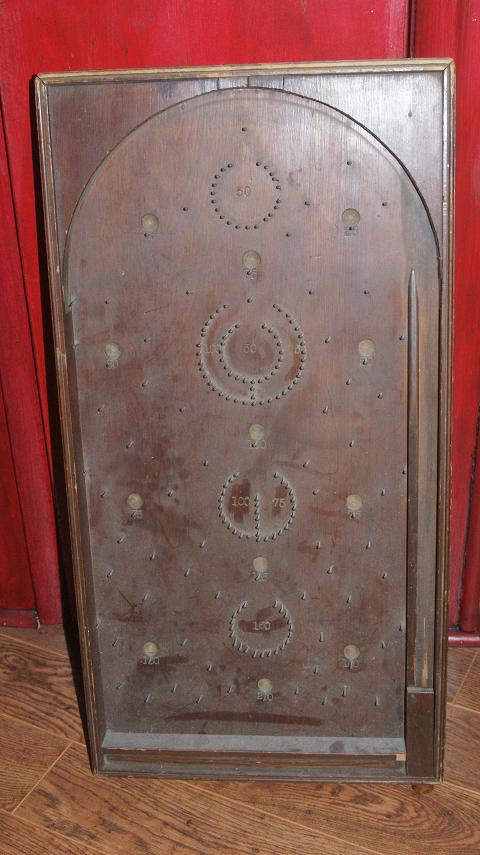 Photo: Original Whiffle Board Game (First Prototype: 1930)
Arthur Paulin (Whiffle Board Inventor)
Photo: Original Whiffle Board Game (First Prototype: 1930)
Arthur Paulin (Whiffle Board Inventor)
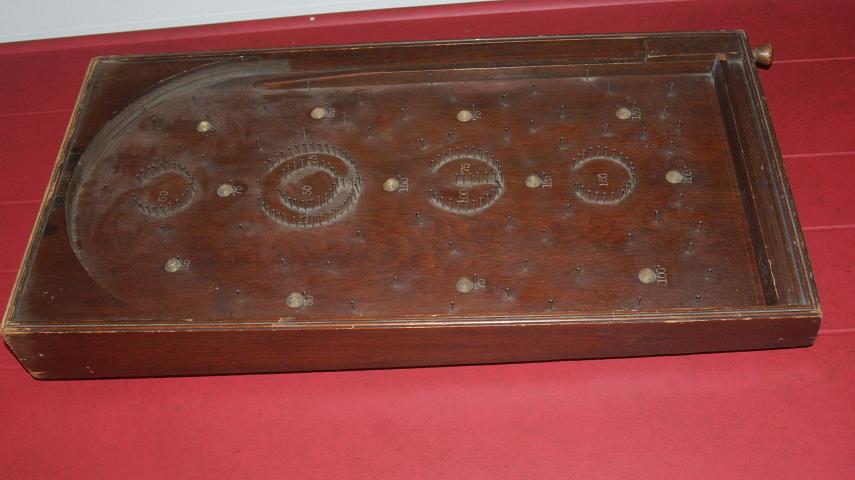 (click on photo's for enlargement)
Whiffle Board (front side)
(click on photo's for enlargement)
Whiffle Board (front side)
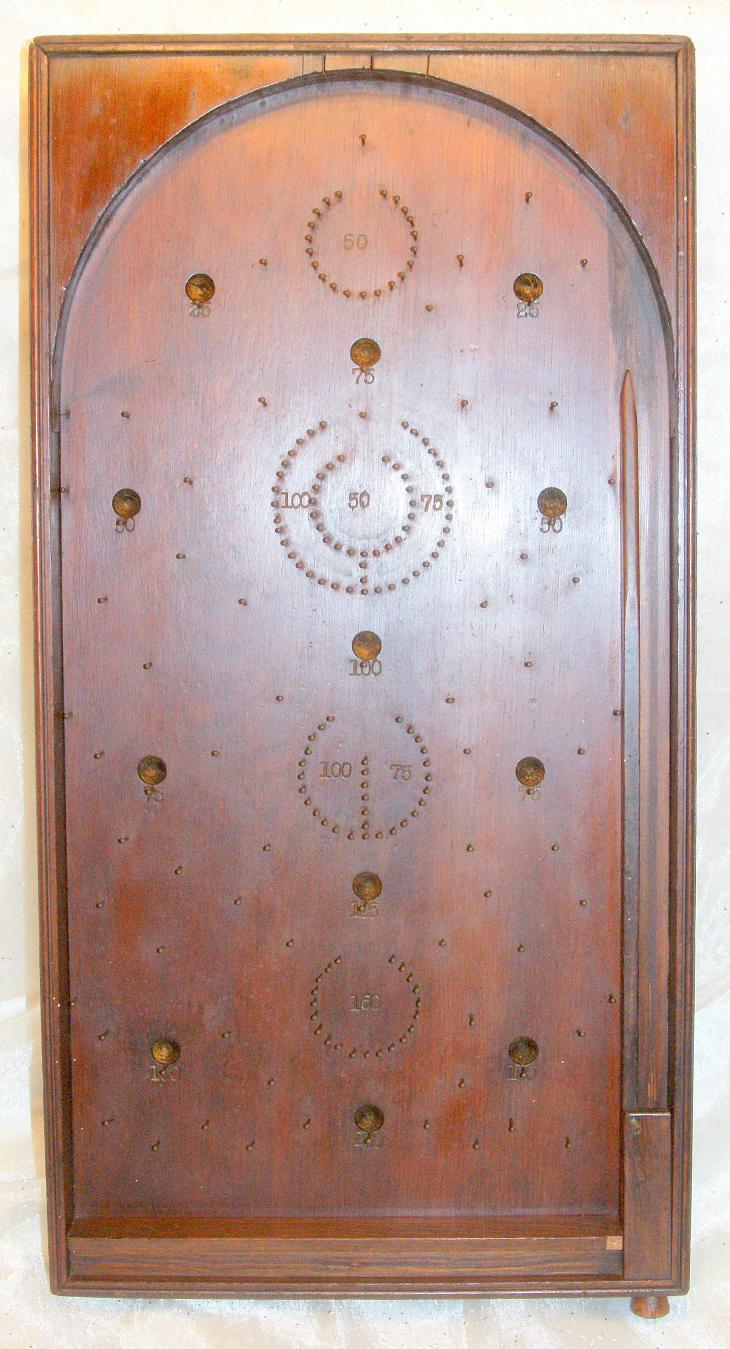 (click on photo's for enlargement)
Whiffle Board (back side)
(click on photo's for enlargement)
Whiffle Board (back side)
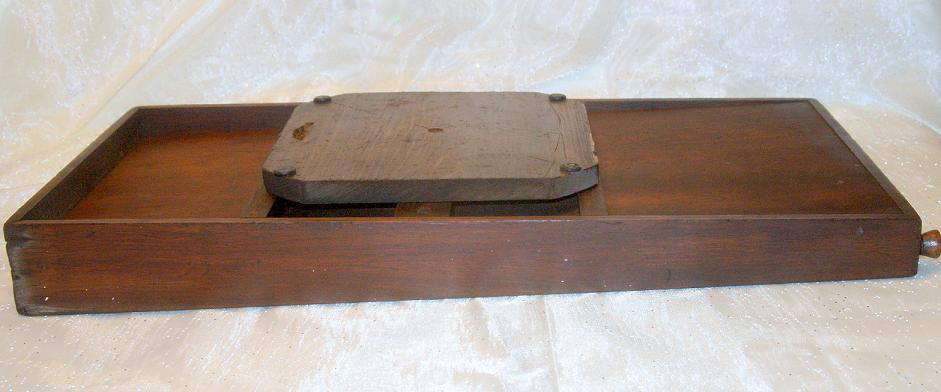 (click on photo's for enlargement)
Whiffle Board (back side indentations - soft nail dots)
(click on photo's for enlargement)
Whiffle Board (back side indentations - soft nail dots)
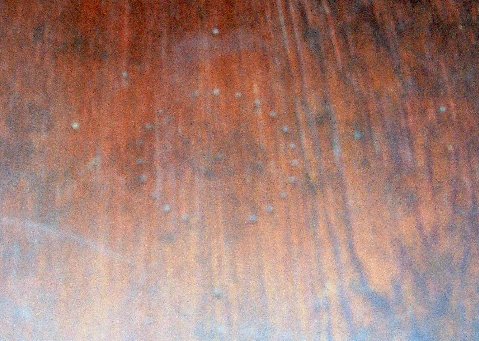 Arthur Paulin (Whiffle Board Inventor)
Arthur Paulin (Whiffle Board Inventor)
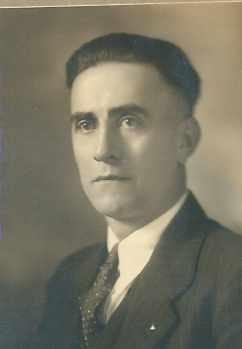 Arthur Paulin a carpenter, was cleaning out his old barn Christmas time 1930,
when he came across an old dusty board with carved out holes and about 30 nail
in it. It looked as if it was about 50 years old. He looked at this board for
a few days and played around with it until he came up with what we now know as
the 'Whiffle Board'. It was during the Great Depression when Youngstown was in
the midst of economic disaster due primarily to the closing of local steel
mills. Money was so tight for Arthur Paulin that he decided to make this
board game up for his daughter Lois Paulin as a Christmas gift.
Arthur Paulin (Photo: First Whiffle Board Invented)
Arthur Paulin a carpenter, was cleaning out his old barn Christmas time 1930,
when he came across an old dusty board with carved out holes and about 30 nail
in it. It looked as if it was about 50 years old. He looked at this board for
a few days and played around with it until he came up with what we now know as
the 'Whiffle Board'. It was during the Great Depression when Youngstown was in
the midst of economic disaster due primarily to the closing of local steel
mills. Money was so tight for Arthur Paulin that he decided to make this
board game up for his daughter Lois Paulin as a Christmas gift.
Arthur Paulin (Photo: First Whiffle Board Invented)
 Arthur Paulin with Daughter, Lois Paulin
Arthur Paulin with Daughter, Lois Paulin
 His daughter loved it so much that she invited her friends to come over and
play this fun board game. Well, next thing you know there was a line all the
way around the house, kids waiting to play this board game! A neighbor of
Paulin's came over and told him he thought he had something big here!
Paulin took the board game to a friend of his, Myrl A. Park who operated a radio
shop. Paulin asked Park, "If I make another one, could I sell it in your shop."
Park was not optimistic about the idea. Park said, "You should put a coin device
on it, let them pay to play."
Paulin like that idea, and took the board game to another friend Earl W. Froom.
Froom was an electrical salesman, he took the board game home and came up with a
coin device for it!
Paulin, Froom, and Park made a number of experiments with the board which they
dubbed as "Old Jenny".
Finally they decided they had it perfected.
Encased with a glass top, four legs, the board had a sloping playfield, a
sliding panel to drop the balls in at the start of the game, and a spring
plunger to shoot the balls. The idea was to put a nickel in the coin device
and that would entitle you to ten (10) balls, nine (9) white marbles, plus a
red one which counted double in points. You would "shoot" to one end of the
board and then the balls rolled down the board again and were deflected into
various holes by nails in the board.
The three men put the board game in a local General Store to test it out. After
one hour they counted the money from the coin device - $2.60! The men couldn't
believe it! Paulin said, "Let's build ten of these."
On January 28th, 1931 the three men went into partnership. Arthur Paulin was
President, and was in charge of construction and manufacture with 1/3
partnership. Earl Froom was Vice President and in charge of sales also with 1/3
partnership. Myrl Park came to assist Paulin and Froom with 1/6 partnership and
another man William Howell who was in charge of all records (secretary) came in
as 1/6 partnership. The company was born! They called it Automatic Industries.
All four men signed a joint note for $300.00 at the Youngstown Bank, the
proceeds of which will be the working capital to be expended for material and
stock in trade of said company. (Documents with Paulin family)
The men rented a second floor of a building. But soon grew out of it! They
decided to rent a house, and again grew out of that. They were making so much
money Froom said, "We've got to pinch ourselves every once in a while to figure
out whether we are dreaming."
The men decided to build there own building because the orders were coming in
from everywhere. Automatic Industries was shipping these Whiffle Boards to
every state in the union. They sold territory rights to dozens of people all
over the country. Some of these people were the most prominent of men in the
country. The company would book orders averaging 27,000 boards a year! Within
a few years, they had passed the $250,000 mark for contracted Whiffle Board
games! At that time, the company employed 53 men in the shop, 11 men and 2
ladies to do the office work. Arthur Paulin said, "I love what I do, but what
makes my heart feel good is that I am able to give 66 people jobs during the
depression!" (Documents with Paulin's family)
Bad times ahead - People and there mothers got on the bandwagon and tried to
recreate the Whiffle Board. A Chicago game manufacturers began producing
copies of the game, and that the 'generic name' for these machines eventually
became "Pinball Game". 'Ballyhoo and Bingo were the biggest to try to stake
claim as the inventors of the first coins devise board games'. A company in
North Carolina actually started coping WHIFFLE, and went so far as to put
Automatic Industries on them. It got so bad that racketeers got involved with
the games business and that they would often smash up other operator's games
on location and put their own games in their place. Froom said, "The problem
got so bad that many places tried to pass laws banning pinball games which
often resulted in court decisions against the games business.
Then came the court battles - Paulin, Froom, and Park went to court to try to
stop others from infringing on Automatic Industries patents. The court battle
lasted for many years! In 1937 a Federal Judge ruled that their patents were
not strong enough to win. This was a bitter defeat for the men after all those
years.
It is to be believed that Earl W. Froom was the inventor of the Whiffle Board.
He was not! He created the coin device for the Whiffle Board, and a partner of
Automatic Industries. It was reported to the Paulin family that after Paulin's
death in 1947, Earl Froom claimed that he was the inventor.
Whiffle Board / Pinball invented by : Arthur L. Paulin
Coin device by : Earl W. Froom
- SOURCES - Story written by Arthur Paulin's daughter Lois Paulin Hollerman
age 82, and Granddaughter Karen Hollerman Kettering; January 4th 2009
I hope you enjoyed the real story about the Whiffle Board and hope you
will share this story on your web site, and all the Pinball lovers out there!!!
Take care and keep on playing, Karen
PS I kinda laughed that you said the Whiffle Board didn't catch on. My
grandfather retired a millionaire.
Ballyhoo Pinball Machine
His daughter loved it so much that she invited her friends to come over and
play this fun board game. Well, next thing you know there was a line all the
way around the house, kids waiting to play this board game! A neighbor of
Paulin's came over and told him he thought he had something big here!
Paulin took the board game to a friend of his, Myrl A. Park who operated a radio
shop. Paulin asked Park, "If I make another one, could I sell it in your shop."
Park was not optimistic about the idea. Park said, "You should put a coin device
on it, let them pay to play."
Paulin like that idea, and took the board game to another friend Earl W. Froom.
Froom was an electrical salesman, he took the board game home and came up with a
coin device for it!
Paulin, Froom, and Park made a number of experiments with the board which they
dubbed as "Old Jenny".
Finally they decided they had it perfected.
Encased with a glass top, four legs, the board had a sloping playfield, a
sliding panel to drop the balls in at the start of the game, and a spring
plunger to shoot the balls. The idea was to put a nickel in the coin device
and that would entitle you to ten (10) balls, nine (9) white marbles, plus a
red one which counted double in points. You would "shoot" to one end of the
board and then the balls rolled down the board again and were deflected into
various holes by nails in the board.
The three men put the board game in a local General Store to test it out. After
one hour they counted the money from the coin device - $2.60! The men couldn't
believe it! Paulin said, "Let's build ten of these."
On January 28th, 1931 the three men went into partnership. Arthur Paulin was
President, and was in charge of construction and manufacture with 1/3
partnership. Earl Froom was Vice President and in charge of sales also with 1/3
partnership. Myrl Park came to assist Paulin and Froom with 1/6 partnership and
another man William Howell who was in charge of all records (secretary) came in
as 1/6 partnership. The company was born! They called it Automatic Industries.
All four men signed a joint note for $300.00 at the Youngstown Bank, the
proceeds of which will be the working capital to be expended for material and
stock in trade of said company. (Documents with Paulin family)
The men rented a second floor of a building. But soon grew out of it! They
decided to rent a house, and again grew out of that. They were making so much
money Froom said, "We've got to pinch ourselves every once in a while to figure
out whether we are dreaming."
The men decided to build there own building because the orders were coming in
from everywhere. Automatic Industries was shipping these Whiffle Boards to
every state in the union. They sold territory rights to dozens of people all
over the country. Some of these people were the most prominent of men in the
country. The company would book orders averaging 27,000 boards a year! Within
a few years, they had passed the $250,000 mark for contracted Whiffle Board
games! At that time, the company employed 53 men in the shop, 11 men and 2
ladies to do the office work. Arthur Paulin said, "I love what I do, but what
makes my heart feel good is that I am able to give 66 people jobs during the
depression!" (Documents with Paulin's family)
Bad times ahead - People and there mothers got on the bandwagon and tried to
recreate the Whiffle Board. A Chicago game manufacturers began producing
copies of the game, and that the 'generic name' for these machines eventually
became "Pinball Game". 'Ballyhoo and Bingo were the biggest to try to stake
claim as the inventors of the first coins devise board games'. A company in
North Carolina actually started coping WHIFFLE, and went so far as to put
Automatic Industries on them. It got so bad that racketeers got involved with
the games business and that they would often smash up other operator's games
on location and put their own games in their place. Froom said, "The problem
got so bad that many places tried to pass laws banning pinball games which
often resulted in court decisions against the games business.
Then came the court battles - Paulin, Froom, and Park went to court to try to
stop others from infringing on Automatic Industries patents. The court battle
lasted for many years! In 1937 a Federal Judge ruled that their patents were
not strong enough to win. This was a bitter defeat for the men after all those
years.
It is to be believed that Earl W. Froom was the inventor of the Whiffle Board.
He was not! He created the coin device for the Whiffle Board, and a partner of
Automatic Industries. It was reported to the Paulin family that after Paulin's
death in 1947, Earl Froom claimed that he was the inventor.
Whiffle Board / Pinball invented by : Arthur L. Paulin
Coin device by : Earl W. Froom
- SOURCES - Story written by Arthur Paulin's daughter Lois Paulin Hollerman
age 82, and Granddaughter Karen Hollerman Kettering; January 4th 2009
I hope you enjoyed the real story about the Whiffle Board and hope you
will share this story on your web site, and all the Pinball lovers out there!!!
Take care and keep on playing, Karen
PS I kinda laughed that you said the Whiffle Board didn't catch on. My
grandfather retired a millionaire.
Ballyhoo Pinball Machine
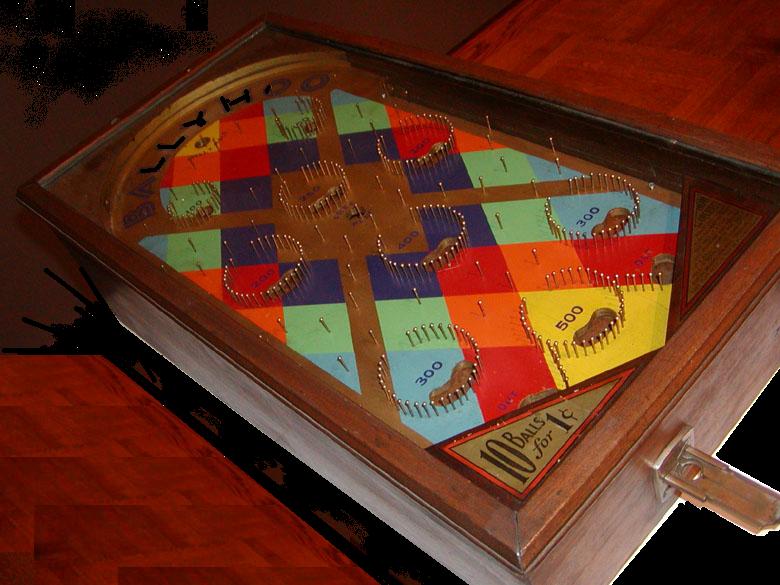
"Whiffle Board", Automatic Ind., circa 1931
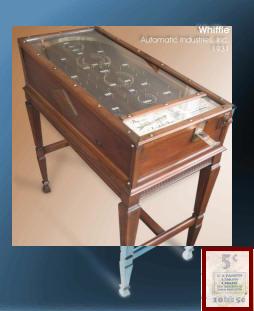 The Whiffle Board is a Pre-Flipper design - Cost 5 cents per play
The game was an instant hit in the Depression-era United States, providing
cheap entertainment for the unemployed masses - and a quick coin-grabbing
business for some shady business operators.
The Whiffle Board is a Pre-Flipper design - Cost 5 cents per play
The game was an instant hit in the Depression-era United States, providing
cheap entertainment for the unemployed masses - and a quick coin-grabbing
business for some shady business operators.
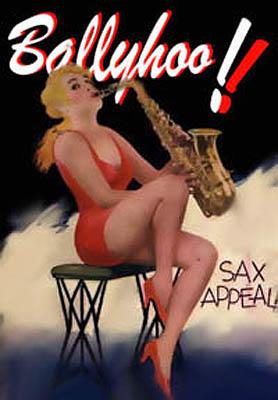
Ballyhoo (1931)
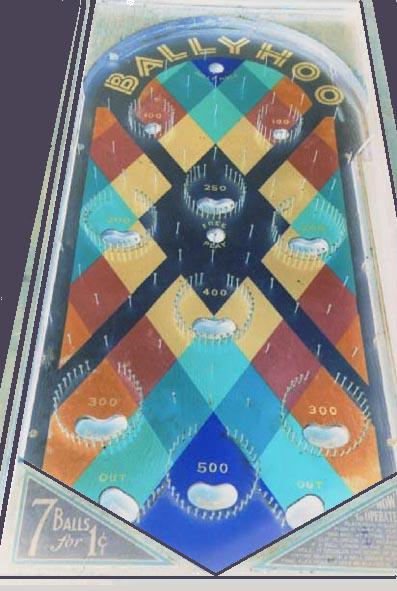 Ballyhoo Pinball was the first pinball game ever made and
was built by Raymond Maloney in 1931. Raymond Maloney later
founded the Bally manufacturing company of Chicago, IL.
Raymond Maloney borrowed the Ballyhoo Pinball Title from the
then famous Magazine, "Ballyhoo".
Ballyhoo Magazine (1931-1939) - Who's name was lended to the Ballyhoo Pinball Title
Ballyhoo Pinball was the first pinball game ever made and
was built by Raymond Maloney in 1931. Raymond Maloney later
founded the Bally manufacturing company of Chicago, IL.
Raymond Maloney borrowed the Ballyhoo Pinball Title from the
then famous Magazine, "Ballyhoo".
Ballyhoo Magazine (1931-1939) - Who's name was lended to the Ballyhoo Pinball Title
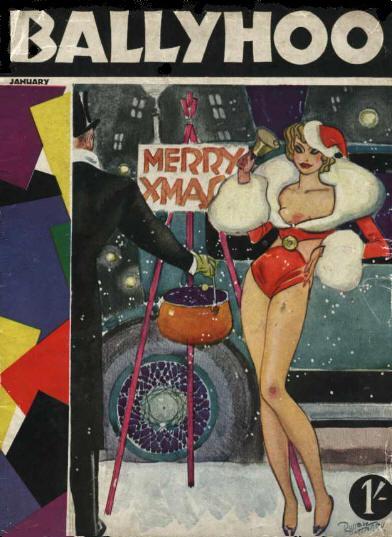
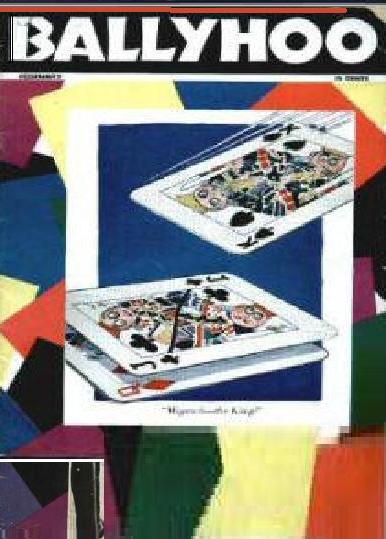 A humor magazine published by Dell. August (1931) thru February (1939)
which gave rise to the first pinball game, Ballyhoo in (1931)
The Ballyhoo humor magazine had a general tone of each magazine as a
characterization of the New Masses with its absurd predictions of imminent
revolution.
"Editorial, 'How Long Shall We Stand For It?'" The first issue of Ballyhoo
Magazine,
Aug. 1931. "Whither? What Next? The crisis? The People? Good times? What Next?
Blah, blah, blah, blah..." The extended Zilch family runs the magazine.
The term pinball was not coined until 1936 when it was noticed
that the ball was manipulated by pins on the playing field much
like the Pachinko machines that had many pins and holes in the
playfield.
There are many skills to learn to master pinball and here are some
tips for ball control. link
The object of the game was still to get a plunger-launched ball into the
desired hole on the playing surface. The Plunger is the object used
to launch a ball onto the playfield. It was now allowed to nudge the
pinball game which is at waist-height. Standing players were able to
"nudge" the machine to change the ball's trajectory. This nudge was
an important part of the game because you could now change how the game
played by how much you shook the game without shaking it so much that
the game would tilt and you would lose your ball or possible your game.
A humor magazine published by Dell. August (1931) thru February (1939)
which gave rise to the first pinball game, Ballyhoo in (1931)
The Ballyhoo humor magazine had a general tone of each magazine as a
characterization of the New Masses with its absurd predictions of imminent
revolution.
"Editorial, 'How Long Shall We Stand For It?'" The first issue of Ballyhoo
Magazine,
Aug. 1931. "Whither? What Next? The crisis? The People? Good times? What Next?
Blah, blah, blah, blah..." The extended Zilch family runs the magazine.
The term pinball was not coined until 1936 when it was noticed
that the ball was manipulated by pins on the playing field much
like the Pachinko machines that had many pins and holes in the
playfield.
There are many skills to learn to master pinball and here are some
tips for ball control. link
The object of the game was still to get a plunger-launched ball into the
desired hole on the playing surface. The Plunger is the object used
to launch a ball onto the playfield. It was now allowed to nudge the
pinball game which is at waist-height. Standing players were able to
"nudge" the machine to change the ball's trajectory. This nudge was
an important part of the game because you could now change how the game
played by how much you shook the game without shaking it so much that
the game would tilt and you would lose your ball or possible your game.
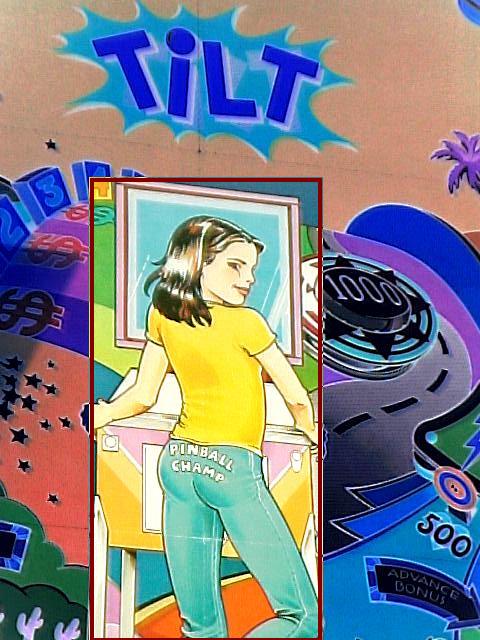 You don't want to Drain the ball. Drain — Where lost balls exit the playfield.
The Apron is the material/item at the very bottom of the playfield, which
usually holds a score and/or instruction card and which covers the ball trough.
The front edges of the apron lead the ball to the drain.
The Outlanes are the outside lanes that usually are placed to the far sides
at the bottom of the playfield and lead to a drain.
Ball Kickers:
Link
In 1933 Harry Williams created the first battery-powered, solenoid-driven,
ball kicker, giving pinball machines the ability to automously power on
its own to kick the ball back up the playfield.
A preview of things to come with Pinball...
You don't want to Drain the ball. Drain — Where lost balls exit the playfield.
The Apron is the material/item at the very bottom of the playfield, which
usually holds a score and/or instruction card and which covers the ball trough.
The front edges of the apron lead the ball to the drain.
The Outlanes are the outside lanes that usually are placed to the far sides
at the bottom of the playfield and lead to a drain.
Ball Kickers:
Link
In 1933 Harry Williams created the first battery-powered, solenoid-driven,
ball kicker, giving pinball machines the ability to automously power on
its own to kick the ball back up the playfield.
A preview of things to come with Pinball...
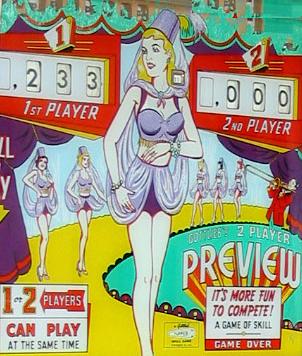 A Game of Skill... A 1962 Gottlieb Pinball Game.
A Game of Skill... A 1962 Gottlieb Pinball Game.
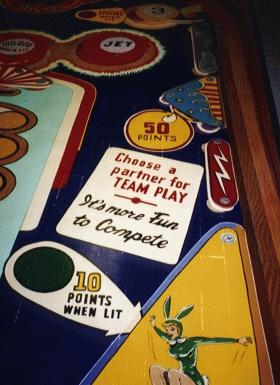 With the addition of electricity, playfield lights and electric bells became
a regular features in 1934. The addition of sound and light made the machines
not only more fun to play. No longer did a ball have to physically strike a bell.
Electric bells, buzzers, and chimes would add sophisticated sound to the games
and make them more exciting. Lights and electric powered sound were two of the
most basic components of the pinball game.
gottlieb's, "Pin-up", Pinball (1975)
With the addition of electricity, playfield lights and electric bells became
a regular features in 1934. The addition of sound and light made the machines
not only more fun to play. No longer did a ball have to physically strike a bell.
Electric bells, buzzers, and chimes would add sophisticated sound to the games
and make them more exciting. Lights and electric powered sound were two of the
most basic components of the pinball game.
gottlieb's, "Pin-up", Pinball (1975)
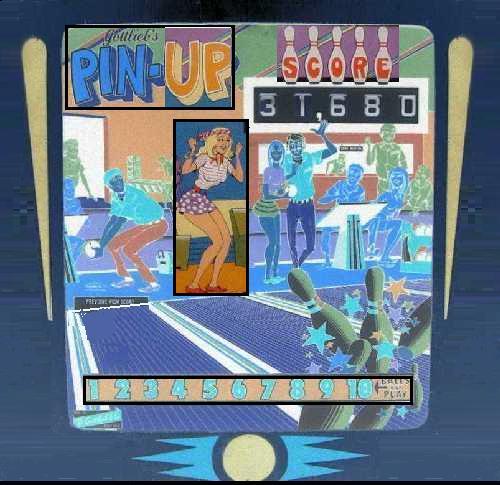 Then in 1936, Bally Manufacturing Company created the Bumper and electric scoring.
The Bally "Bumper" pinball machine was now in all types of pinball games. The
bumper made is physically possible for the ball to be propelled rapidly from one
bumper to the next by rapidly bouncing from one spring bumper to the next because
of a electronic coiled spring mechanism giving force to the spring action.
The triggered switch was connected to the first electric scoring circuitry
called a "totalizer." Depending on how many bumpers were hit, lights could be
triggered on to illuminate a previously unseen score that was painted behind
translucent glass.
the Totalizer was there to add up how many times the bumpers had been hit!
Gottlieb's, "Happy Days", Pinball (1934)
Then in 1936, Bally Manufacturing Company created the Bumper and electric scoring.
The Bally "Bumper" pinball machine was now in all types of pinball games. The
bumper made is physically possible for the ball to be propelled rapidly from one
bumper to the next by rapidly bouncing from one spring bumper to the next because
of a electronic coiled spring mechanism giving force to the spring action.
The triggered switch was connected to the first electric scoring circuitry
called a "totalizer." Depending on how many bumpers were hit, lights could be
triggered on to illuminate a previously unseen score that was painted behind
translucent glass.
the Totalizer was there to add up how many times the bumpers had been hit!
Gottlieb's, "Happy Days", Pinball (1934)
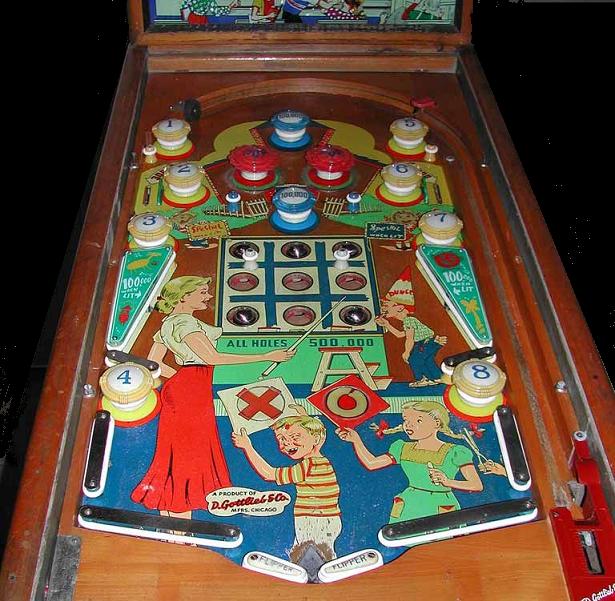 In 1934, the tilt mechanism was devised so players could not
cheat the game and play forever by disturbing the entire playfield.
There are two tilt sensors in the newest technology. The standard movement
tilt and the slam tilt. Slam tilts are made to stop major cheating like
slamming the game on the ground. There is a tilt warning given the metal
pendulum rod inside the pinball game touches the metal ring.
Major abuse of the tilt mechanism will cause a forfeiture of your pinball game.
The specter of gambling hung heavily over the pinball industry, which was
widely suspected of being a front for organized crime. So serious was the
threat that on January 21, 1942 a blanket ban on the game was imposed in
New York City.
January 21, 1942 - Pinball Becomes Illegal in New York City
Pinball was banned in New York City because it was viewed as a game of luck rather
than a game of skill (Gambling games are illegal in New York City)
Bally's, "Evil Knievel" Pinball Flyer (1976)
In 1934, the tilt mechanism was devised so players could not
cheat the game and play forever by disturbing the entire playfield.
There are two tilt sensors in the newest technology. The standard movement
tilt and the slam tilt. Slam tilts are made to stop major cheating like
slamming the game on the ground. There is a tilt warning given the metal
pendulum rod inside the pinball game touches the metal ring.
Major abuse of the tilt mechanism will cause a forfeiture of your pinball game.
The specter of gambling hung heavily over the pinball industry, which was
widely suspected of being a front for organized crime. So serious was the
threat that on January 21, 1942 a blanket ban on the game was imposed in
New York City.
January 21, 1942 - Pinball Becomes Illegal in New York City
Pinball was banned in New York City because it was viewed as a game of luck rather
than a game of skill (Gambling games are illegal in New York City)
Bally's, "Evil Knievel" Pinball Flyer (1976)
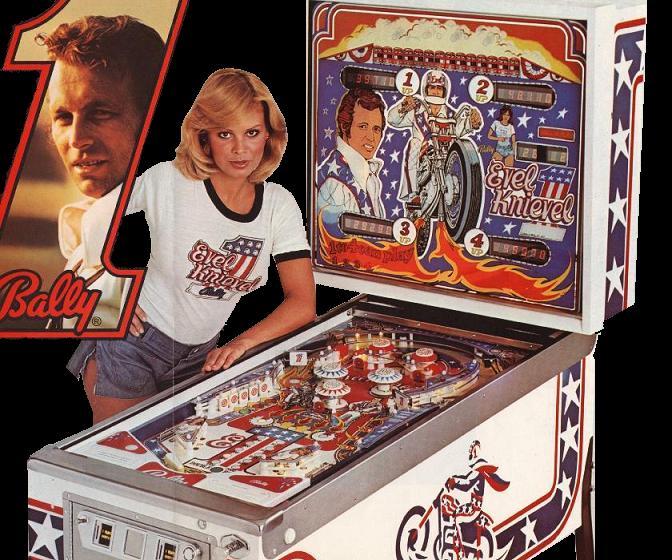 Mayor Fiorello Henry LaGuardia smashed a number of machines
The ban lasted until 1976. Free games (replays, matches, etc.)
Continue to be illegal in New York City to this day, although the law
goes unenforced.
The Add-A-Ball feature was added:
A feature designed to provide a reward to the player in regions where replays
(free games) were outlawed as a thing of value, making pinball into gambling.
Add-A-Ball games allow the player to be awarded multiple additional balls, and
usually include a counter showing balls remaining to play
Lever-operated flippers introduced the element of skill that was lacking in
previous incarnations - a useful counter-argument to politicians and moralizers
who claimed pinball was a front for gambling.
Humpty Dumpty Flyer
Mayor Fiorello Henry LaGuardia smashed a number of machines
The ban lasted until 1976. Free games (replays, matches, etc.)
Continue to be illegal in New York City to this day, although the law
goes unenforced.
The Add-A-Ball feature was added:
A feature designed to provide a reward to the player in regions where replays
(free games) were outlawed as a thing of value, making pinball into gambling.
Add-A-Ball games allow the player to be awarded multiple additional balls, and
usually include a counter showing balls remaining to play
Lever-operated flippers introduced the element of skill that was lacking in
previous incarnations - a useful counter-argument to politicians and moralizers
who claimed pinball was a front for gambling.
Humpty Dumpty Flyer
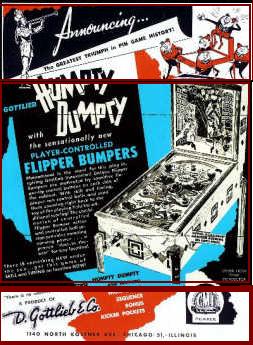 First Pinball Flipper Game
Humpty Dumpty Pinball (1947)
First Pinball Flipper Game
Humpty Dumpty Pinball (1947)
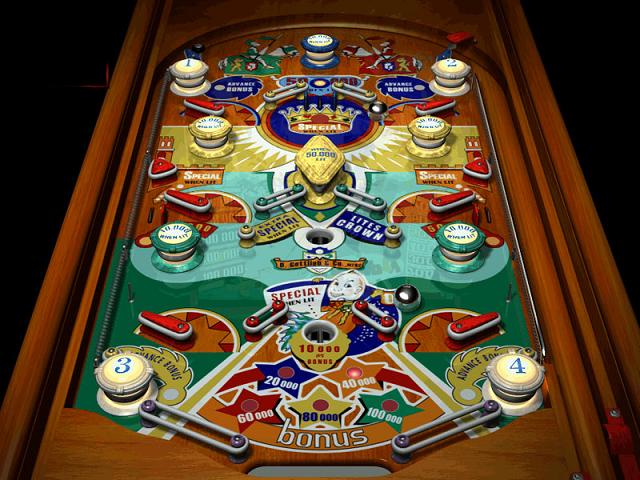 1947 The fist game to use flippers was Humpty Dumpty, by Gottlieb.
It was invented by Harry Mabs and had six side flippers of which
three were on each side.
Notice that the flippers are backwards and very small in size. It was
not until 1970 that the flippers became as large as they are today.
The longer 3 inch flippers are what we use today except when it comes
to some skill shot flippers set up near the middle of the playing field
like in the Addams family, a three flipper game.
The ten year period of 1948-58 is referred to by some as the "Golden Age" of
pinball, due to the invention of flippers in 1947.
Spot bowler backglass (1950)
1947 The fist game to use flippers was Humpty Dumpty, by Gottlieb.
It was invented by Harry Mabs and had six side flippers of which
three were on each side.
Notice that the flippers are backwards and very small in size. It was
not until 1970 that the flippers became as large as they are today.
The longer 3 inch flippers are what we use today except when it comes
to some skill shot flippers set up near the middle of the playing field
like in the Addams family, a three flipper game.
The ten year period of 1948-58 is referred to by some as the "Golden Age" of
pinball, due to the invention of flippers in 1947.
Spot bowler backglass (1950)
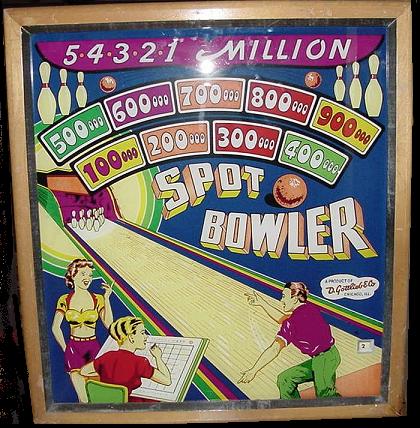 The black glass is the glass within the front of the backbox,
with ink artwork silk-screened onto the back of it. The Backbox
is the upright part of a pinball machine that holds the backglass
and any displays and scoring mechanisms.
The black glass is the glass within the front of the backbox,
with ink artwork silk-screened onto the back of it. The Backbox
is the upright part of a pinball machine that holds the backglass
and any displays and scoring mechanisms.
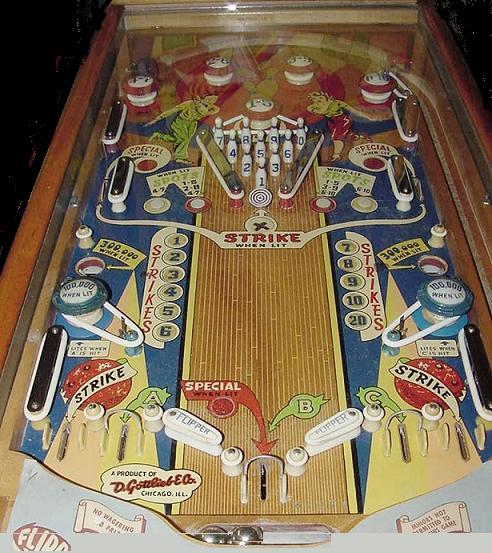 Spot Bowler Pinball (1950)
Notice the wooden side rails and all wood paneling
which are not seen in today's pinball games.
Woodrail is a term referring to games manufactured prior
to around 1961 that used wood to frame the playfield.
The first game that had the flippers set at the bottom of the playfield
as we see them today is probably Spot Bowler, a 1950 Gottleib game.
Steve Kordek designing the playfield for the 1948 Genco game "Triple Action",
in which he had put flippers at the bottom of the playfield. These early
flippers operated in the reverse direction of those used now and one button
could operate both flippers. The flippers could not be held up by continuously
pressing the flipper button as they are today.
Vagabond Backglass (1962)
Spot Bowler Pinball (1950)
Notice the wooden side rails and all wood paneling
which are not seen in today's pinball games.
Woodrail is a term referring to games manufactured prior
to around 1961 that used wood to frame the playfield.
The first game that had the flippers set at the bottom of the playfield
as we see them today is probably Spot Bowler, a 1950 Gottleib game.
Steve Kordek designing the playfield for the 1948 Genco game "Triple Action",
in which he had put flippers at the bottom of the playfield. These early
flippers operated in the reverse direction of those used now and one button
could operate both flippers. The flippers could not be held up by continuously
pressing the flipper button as they are today.
Vagabond Backglass (1962)
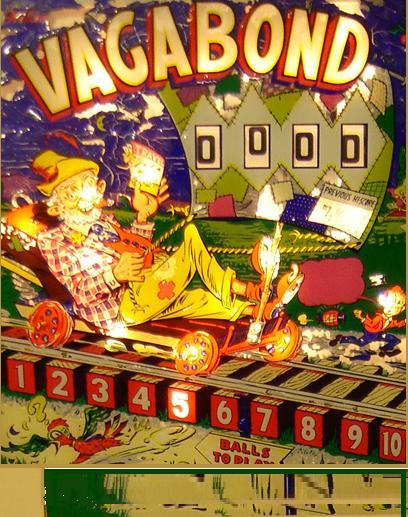
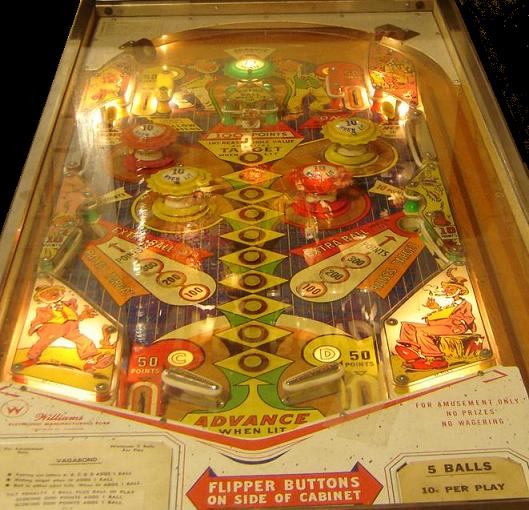 Vagabond Pinball Playfield (1962)
1962 Drop targets, were introduced in the 1962 pinball game, Williams' Vagabond.
The target which is located straight up the middle and towards the top of the play
field. Hitting the hobo drop target for an extra ball never gets old. A Drop Target
is a type of standup target that is dropped into or below the playfield when hit.
Mr. Kordek put in the first simultaneous multiple balls play, "multiball" on
the playfield (William's Beat The Clock, 1963), and the drop target
(William's Vagabond, 1963).
1976 Pinball is a game of skill and deemed (Not Gambling) -
Testifying before the New York City Council at a hearing on pinball in
April 1976, Sharpe, then a 27-year-old magazine editor in Manhattan,
played three balls on a Gottlieb Bankshot, explaining to his audience
as he played how pinball was a game of skill, not of chance. Sharpe
tells what happened next: "'Even down to this plunger,' I told them,
'there's skill. If I pull this back the right way, I should be able to
send the ball into the middle slot.' I actually specified a lane,
which, in retrospect, I probably should not have done. I pulled back
the plunger, and wouldn't you know, boom boom, it went straight down
where I had said [it would go]. These people kind of threw up their
hands and said, 'All right. Enough. Fine, thanks.'"
The council reinstated pinball in New York City that summer. (Source:
Cigar Aficiado).
It was also in the mid 1970's that solid-state (or electronic) pinball machines
were first introduced, starting yet another huge wave of public popularity due
to new games innovations, features, Game reliability and cool design features
like electronic scoring, alphanumeric scoring, electronic sounds and finally
electronic speech, which lasted well into the late 1980's.
The Invention of the Autoplunger
Many newer games feature an automatic plunger that launches the ball at the touch
of a button, or which the game uses to launch additional balls into play for
various reasons — for example, to launch additional balls onto the playfield
for multiball.
There is the Ball Saver which will return a drained ball withing the first few
seconds of play is said to be equipped with a 'ball saver'. The ball is returned
to the plunger. The automatic Ball Search is done when a machine has not seen any
scoring in a few seconds and thinks the ball may be stuck, it will quickly activate
each solenoid in the machine in turn, to help a ball become unstuck if it happens
to be mechanically hung up, or in case the ball has been captured by a playfield
mechanism with a faulty indicator switch. This procedure is called a 'ball search',
and may happen several times before the game either shuts down or ejects a replacement
pinball.
Vagabond Pinball Playfield (1962)
1962 Drop targets, were introduced in the 1962 pinball game, Williams' Vagabond.
The target which is located straight up the middle and towards the top of the play
field. Hitting the hobo drop target for an extra ball never gets old. A Drop Target
is a type of standup target that is dropped into or below the playfield when hit.
Mr. Kordek put in the first simultaneous multiple balls play, "multiball" on
the playfield (William's Beat The Clock, 1963), and the drop target
(William's Vagabond, 1963).
1976 Pinball is a game of skill and deemed (Not Gambling) -
Testifying before the New York City Council at a hearing on pinball in
April 1976, Sharpe, then a 27-year-old magazine editor in Manhattan,
played three balls on a Gottlieb Bankshot, explaining to his audience
as he played how pinball was a game of skill, not of chance. Sharpe
tells what happened next: "'Even down to this plunger,' I told them,
'there's skill. If I pull this back the right way, I should be able to
send the ball into the middle slot.' I actually specified a lane,
which, in retrospect, I probably should not have done. I pulled back
the plunger, and wouldn't you know, boom boom, it went straight down
where I had said [it would go]. These people kind of threw up their
hands and said, 'All right. Enough. Fine, thanks.'"
The council reinstated pinball in New York City that summer. (Source:
Cigar Aficiado).
It was also in the mid 1970's that solid-state (or electronic) pinball machines
were first introduced, starting yet another huge wave of public popularity due
to new games innovations, features, Game reliability and cool design features
like electronic scoring, alphanumeric scoring, electronic sounds and finally
electronic speech, which lasted well into the late 1980's.
The Invention of the Autoplunger
Many newer games feature an automatic plunger that launches the ball at the touch
of a button, or which the game uses to launch additional balls into play for
various reasons — for example, to launch additional balls onto the playfield
for multiball.
There is the Ball Saver which will return a drained ball withing the first few
seconds of play is said to be equipped with a 'ball saver'. The ball is returned
to the plunger. The automatic Ball Search is done when a machine has not seen any
scoring in a few seconds and thinks the ball may be stuck, it will quickly activate
each solenoid in the machine in turn, to help a ball become unstuck if it happens
to be mechanically hung up, or in case the ball has been captured by a playfield
mechanism with a faulty indicator switch. This procedure is called a 'ball search',
and may happen several times before the game either shuts down or ejects a replacement
pinball.
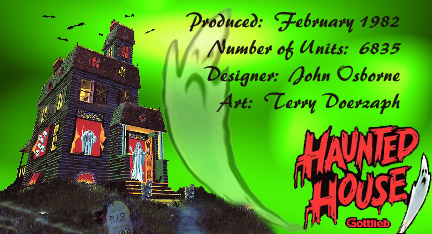 Haunted House (1982) Design Team
Haunted House (1982) Design Team
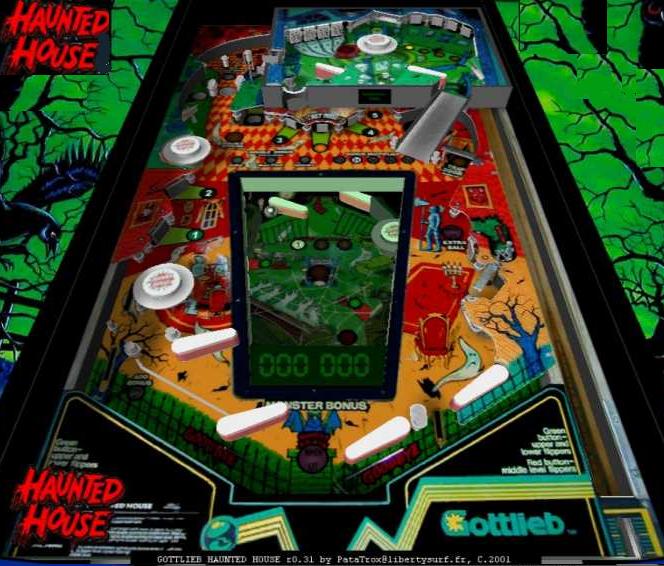 Haunted House (1982)
1982 - Gottliebs 1982Haunted House" winning the award with a total of eight
flippers. Haunted House was also the first game to have with three playing fields
(an upper and lower field in addition to the main playing field) and the
first vertical ball 'upkicker", invented by John Osborne.
Revenge From Mars and Star Wars games was the attempt by Williams manufacturing to
merge video games and pinball formats together.
In the late 1980's Williams and Bally merged to become the dominant player
in the pinball market.
Their big hits: Medieval Madness, Cirqus Voltaire, Twilight Zone, Theatre Of Magic,
Monster Bash, Scared Stiff, Tales Of The Arabian Nights
They later folded with only one player left in the industry.
Stern Pinball is the only pinball manufacturer that could stay in business after
the great demise of pinball games after the strong presence of video games.
With one exceptional game that outplays the rest link
Haunted House (1982)
1982 - Gottliebs 1982Haunted House" winning the award with a total of eight
flippers. Haunted House was also the first game to have with three playing fields
(an upper and lower field in addition to the main playing field) and the
first vertical ball 'upkicker", invented by John Osborne.
Revenge From Mars and Star Wars games was the attempt by Williams manufacturing to
merge video games and pinball formats together.
In the late 1980's Williams and Bally merged to become the dominant player
in the pinball market.
Their big hits: Medieval Madness, Cirqus Voltaire, Twilight Zone, Theatre Of Magic,
Monster Bash, Scared Stiff, Tales Of The Arabian Nights
They later folded with only one player left in the industry.
Stern Pinball is the only pinball manufacturer that could stay in business after
the great demise of pinball games after the strong presence of video games.
With one exceptional game that outplays the rest link
Just for fun I asked Jim Belsito, top pinball player in the world, how
much skill versus luck there is in pinball.
His Reply was 70% Skill, and 30% luck!
Thanks, Paul Dean
Back to: Walter Day Conversations
Click here to bookmark this page!